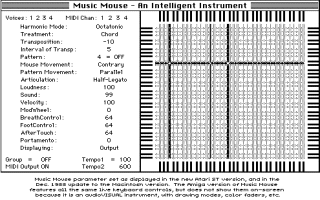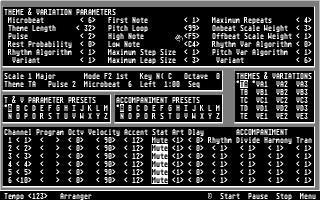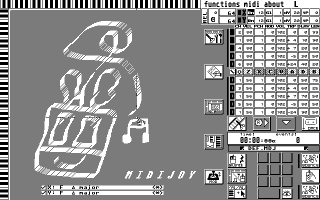Tim Conrardy gives us an overview
of Atari MIDI applications on the more "exotic"
end of the musical spectrum
Back in the days when MIDI (Musical
Instrument Digital Interface) was still in its infancy
(1983 onward) Atari was ahead of the game by providing
MIDI ports on all its computers. Thus were
born many innovative and experimental applications the
likes we have not even seen today in our age of “production”
digital audio workstations. These applications were
meant for interaction between man and machine. They
were played in real-time by the performer, using
the computer as an instrument in its own right. These
programs were known as algorithmic music applications.
The term, “algorithmic” conjures in some people's minds
a sense of “randomness” and “computer-generated music”.
While certainly it entails the computer carrying out
musical decisions, it is not at all random, but it is
the performer who gives the computer instructions to
achieve the desired goal.

A case in point would be Music Mouse
by Laurie Spiegel. Originally coded for the Mac, it
was ported to the ST platform in 1988 with the help
of David Silver. This program turns the Atari
into a musical instrument in its own right with complete
control in the hands of the performer. Basically it
takes mouse movements inside a grid and transforms them
into four moving voices .The voices can be assigned
different MIDI channels and sounds .With actions you
perform on the QWERTY keyboard you can control
other aspects of the sound such as volume, transposition,
panning and a host of other features. While Music Mouse
is fun to use and creates an instant gratification of
the senses, it can also get quite deep as you explore
and refine mouse and QWERTY keyboard techniques. Music
Mouse is still available for the Atari platform direct
from the programmer (http://retiary.org/Is/programs.html).
During this time period many other
algo-comp applications came onto the market. Companies
such as Intelligent Music produced classics such as
“M” the interactive performance system by David Zicerelli
and ported to the ST platform by Eric Ameres. M became
a favorite in experimental circles. The Mac version
is still being upgraded by David Zicerelli (http://www.cycling74.com).
Intillegent Music also produced MidiDraw by Frank Balde.
MidiDraw is a MIDI graphical painting program in which
you can actually draw pictures on the computer screen
with the mouse and it’s translated into sound. In addition
a very unique MIDI sequencer was produced called RealTime
by Eric Ameres which incorporated features of M and
offered other algorithmic possibilities. All of these
programs had a feature that allowed you to record your
interaction with the program . When your interaction
was completed, you were able to save whatever was performed
as a standard MIDI file. From there the MIDI file could
be exported to another MIDI sequencer program for inclusion
in a larger piece.

Another algorithmic application came
from Hybrid Arts programmer Tom Bajoras, who created
Ludwig. This application was different then the Intelligent
Music applications in that you selected “operations”
. An operation was the actual algorithm that would happen
within a “cell” which is a block of time. A pattern,
which could be a scale or melody could also be selected.
The program has different operations that apply to pitch,
rhythm and velocity. For example, operations of pitch
included algorithms called: reverse, warp harmony, invert
chords, randomize, play odd/even, reflect, substitute
rest, and drop a chord. All these could be applied to
a pattern that the user created. The same algorithms
could be applied to the rhythms operation with similar
transformations. In time, a library could be built of
patterns and rhythms so you could have starting points
or “bones” as Ludwig calls it, to work with. Historical
note: the name, “Ludwig” came not from Mr Beethoven,
but was the name of the R&D director’s dog!
Another famous company known for very
unique MIDI applications was Dr T. Software. Producing
software for multi-platforms, its strength was in applications
developed for the Atari. The flagship was called Omega
II KCS created by Emile Tobenfeld. This incorporated
an unusual editing module called the PVG (Programmable
Variation Generator) which “is arguably the most powerful
composition system ever seen on this planet” (PVG manual).
Basically you could take a small section of notes and
transform them using the many tools available in PVG.
Some of these involve random processes, while others
are very deterministic. This allowed for a very flexible
composition package, which was not linear as in most
sequencers offered today. There was also the OPEN MODE
in KCS, which allowed you to have 128 different sequences
or patterns in memory. The sequences could be triggered
with keys on the computer QWERTY keyboard. This allowed
interaction that would be impossible on a linear style
sequencer. You could basically do a live performance
using the computer keyboard.

Other algorithmic products from Dr
T were Tunesmith by Jim Johnson and Fingers by Emile
Tobenfeld. These were phrase generators capable of intoxicating
intricate patterns, which also had a live performance
element to them. You could change any of the parameters
in real time as the music was playing. They also integrated
into KCS as MPE (Multi-program Environment) modules
so whatever you did in Tunesmith or Fingers, it would
record right onto a sequencer track. This was musical
multitasking, ahead of its time. Today Emile Tobenfeld
is creating video at http://www.foryourhead.com. Jim Johnson is still creating MIDI
products at http://www.technotoys.com.
Other algo-comp applications would
include auto-accompaniment programs. The program from
PG Music called Band-In-a-Box offered a music minus
one scenario with styles you could play along with.
However, they also offered a way for users to create
their own styles and this is where the algorithmic elements
come into play. The program “Freestyle” from SoundPool
GmbH could also be grouped into the same style of applications.

Today, a good majority of these applications
are now freeware, thanks to the original programmers
who gave their permission. With the release of these
applications, more Atari algo-comp applications are
coming out of the woodwork such as MIDI JOY by Harry
Kooperman, David Snow’s many Atari MIDI applications,
AFSTS, the Algorithmic Film Sound Track System by Christian
Banasik and Fractal Music Composer by Hugh McDowell
(former cello player with Electric Light Orchestra).
Omega KCS is also now shareware with upgrades
available from Dr T himself.
With the help of Algorithmic Applications
we can explore a new world of possibilities that we
have only begun to fathom in the depths of our musical
heritage.
Tim’s Atari Midi World
http://sites.netscape.net/timconrardy/index.htm |